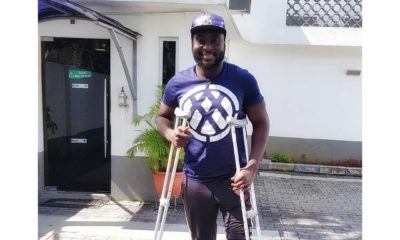Features
Opeyemi Bakre: Why Does My Neck Hurt So Bad?
Just like the elastic band, our neck muscles, ligaments, tendons, nerves and blood vessels are stretchable. They stretch and are under so much stress and pressure that they get to the limit of their elasticity and begin the plasticity phase. At this point, one may begin to feel some dull aches and pains, some tingling sensations in the neck going to your shoulder, you may constantly have to ‘crack’ your neck to make it feel alright.
 The human body is so fascinating, reaching heights and depths that the vessel living in the body can only sometimes dream of. This amazing work of art can mould, bend, wiggle, stretch and is capable of breaking. Think of your high school physics class, and your instructor is going on about the elastic band, A.K.A rubber band. The rubber band is such a fascinating piece. I love its versatility. It is committed to whatever you subject it to and is able to withstand pressure for so long. You can stretch it out and use it again and again. The teacher talks about the yield point and while you’re still grasping the concept, he mentions the breaking point.
The human body is so fascinating, reaching heights and depths that the vessel living in the body can only sometimes dream of. This amazing work of art can mould, bend, wiggle, stretch and is capable of breaking. Think of your high school physics class, and your instructor is going on about the elastic band, A.K.A rubber band. The rubber band is such a fascinating piece. I love its versatility. It is committed to whatever you subject it to and is able to withstand pressure for so long. You can stretch it out and use it again and again. The teacher talks about the yield point and while you’re still grasping the concept, he mentions the breaking point.
According to Quora, “The yield point is a point on the stress-strain curve which indicates the limit of elastic behaviour and the beginning of plastic behaviour. During tensile deformation, materials initially deform elastically and the yield point marks the onset of plastic deformation.”
What this means is that the continuous use – stretching, bending and twisting of the rubber band will eventually take it beyond the normal circular configuration. It is now not as firm or elastic as it used to be. Although it is not broken yet, it, however, is now different from when you newly got it. The plastic behaviour is that it can no longer stretch. Any stress after this point will break or cut the rubber band. This phenomenon applies to other materials too such as steel and the human body.
Andy Stanley once said that “bad behaviour is only repeated because it is rewarded”. Everybody is doing it – ‘na one thing go kill person’, ‘na phone I use I no (insert witty comment)‘. The point here is, the more you continue to engage in poor postural habits, the more comfortable it gets because no one is cautioning you. Well, here I am. Constant use of mobile devices in the wrong way will like, the rubber band, stretch, hurt your neck muscles, bones, ligaments, tendons, nerves, blood vessels until they give way. Experts recommend a range of 0 – 30 degrees for any device you’re using. That means having the device at between eye level and chin level. This applies to your PCs at work, at home and handheld smarties.
Just like the elastic band, our neck muscles, ligaments, tendons, nerves and blood vessels are stretchable. They stretch and are under so much stress and pressure that they get to the limit of their elasticity and begin the plasticity phase. At this point, one may begin to feel some dull aches and pains, some tingling sensations in the neck going to your shoulder, you may constantly have to ‘crack’ your neck to make it feel alright. Sometimes, you notice you must turn your whole body around to look to your side (rather than just turning your neck). These symptoms are not conclusive and may vary in individuals. When these progresses, the normal curve of the cervical spine (bones of the neck) is compromised. A straightening of the curve, pain, muscle spasms, and sometimes an obvious physical change in neck orientation may be seen.
The good news is that there is help. A saying I love so much is “Prevention is not only better than cure, prevention is cheaper than cure”. That means, starting this very moment, you raise your screen level to within 0 – 30 degrees, take breaks at least every 30mins from looking at a screen and perform these simple exercises:
- Look up and down – push your head back on your neck (picture that head over neck slide dance move when your favourite beats come up) and tilt head upwards as far as you can go. Then, with the head still pushed back on the neck, attempt to bring your chin to your chest. Don’t worry if it doesn’t get there. Hold each position for 10seconds and repeat 3 times.
- Look left and right – no, you’re not crossing the express here, but still do this when you are. Push head back on the neck – as in the point above, and attempt to bring your chin to align with your left shoulder. Slump your shoulders and do not raise them. Repeat on the right side. Hold each position for 10seconds and repeat 3 times.
- Bend left and right – again, push the head back on the neck and attempt to touch the left ear to the left shoulder. Slump your shoulders and do not raise them to touch the ear. Instead, ensure you bring the ear down to the shoulder. Repeat on the right side. Hold each position for 10seconds and repeat 3 times.
- Now combine points 1 and 2 above to get a circular motion. Ensure shoulders are down, not raised. Repeat 3 times.
If your symptoms are like the ones described above, please schedule an appointment with your physiotherapist as soon as possible.



















